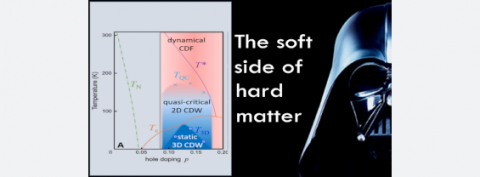Dynamical charge density fluctuations pervading the phase diagram of a Cu-based high-Tc superconductor

Electrons in solid metals customarily belong to the so-called `hard condensed matter.’ They are usually highly mobile, minimize their energy by forming Bloch states, and are uniformly distributed in the whole system, as they essentially behave as a free electron gas (although correlations and the lattice may `dress’ them, giving rise to fermionic quasiparticles with more or less increased effective mass). This standard `textbook’ situation may drastically change when the metallic state is characterized by low electron density, `lives’ in a reduced dimensionality, or competes with other phases of matter. Over the last two or three decades, hard condensed matter has faced an increasing interest in low-dimensional electrons systems and competing electronic phases.
On the one hand, low-dimensional systems are of interest for nanoscopic devices because they are obviously smaller than bulky systems, because layers can be somewhat `adjusted’ with external parameters, like strain, and the electron density can be more easily tuned with doping and gate fields. On the other hand, specific phenomena occur in low-dimensional systems, where ordered states are more hardly realized, opening the way to competitions between different phases (insulating, superconducting, magnetic, charge-ordered, …). The key point is that all these effects are often accompanied by some form of softening of the electronic matter. In other words, when the electron density is the relevant parameter ruling the competition between phases, large fluctuations in the electron density occur leading to a generic softness (i.e., large compressibility) of the electronic matter. The consequences may be various, ranging from high-temperature superconductivity, to glassy or nanoscopically inhomogeneous coexisting states. These issues, that are of obvious fundamental and applicative interest, have been theoretically addressed along the years by some people in Rome in collaboration with important italian and foreign experimental groups (see attached file). In particular in a recent work published on Science it has been assessed that electron softness is widely at work in high-temperature superconducting cuprates, in the form of fluctuating electronic charge density waves. In this metallic state, the electron gas constantly feels `frissons’ of density fluctuations, that greatly alter the metallic properties, giving rise to the highly anomalous behavior observed in these systems. What has remarkably been found [1] is that these `shivers’ of the electron gas are not a minor accessory phenomenon, rather they uniformly pervade the phase diagram of cuprates.
This form of electron softness is therefore a constitutive characteristic of these systems. In conclusion, the quite common occurrence, although in various forms, of electron softness in different systems and materials (see attached file) strongly suggests that it might be a rather universal feature of low-density and/or low-dimensional electronic states. [1] Dynamical charge density fluctuations pervading the phase diagram of a Cu- based high-Tc superconductor. R. Arpaia, S. Caprara, R. Fumagalli, G. De Vecchi, Y.Y. Peng, E. Andersson, D. Betto, G. M. De Luca, N. B. Brookes, F. Lombardi, M. Salluzzo, L. Braicovich, C. Di Castro, M. Grilli, and G. Ghiringhelli, Science (2019), https://science.sciencemag.org/cgi/doi/10.1126/science.aav1315
Sience
Authors
R. Arpaia, S. Caprara, R. Fumagalli, G. De Vecchi, Y.Y. Peng, E. Andersson, D. Betto, G. M. De Luca, N. B. Brookes, F. Lombardi, M. Salluzzo, L. Braicovich, C. Di Castro, M. Grilli, and G. Ghiringhelli
